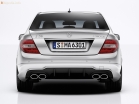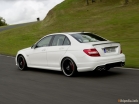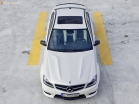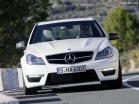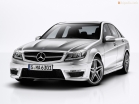Test drive Mercedes Benz C-class AMG sedan since 2011 sedan
Silver arrow
 Today, few people remember why the Mercedes sports cars began to be called silver arrows. It hurts a lot of water from that time, as in June 1934, the team of Alfred Neibauer had to scrap white paint from the Mercedes racing all night. Only in this way, having scraped more than a kilogram of varnish, Stuttgart mechanics could facilitate the new W25A so that their weight does not exceed the 750 kg Grand Prix permissible rules. The next morning, sparkling with naked aluminum bodies, Mercedes safely passed the technical commission, and Manfred von Brauhich brought cars with a three -beam star on the hood victory in the Eiffel races. Since then, the silver color has become the embodiment of the sports spirit and the success of the brand.
Today, few people remember why the Mercedes sports cars began to be called silver arrows. It hurts a lot of water from that time, as in June 1934, the team of Alfred Neibauer had to scrap white paint from the Mercedes racing all night. Only in this way, having scraped more than a kilogram of varnish, Stuttgart mechanics could facilitate the new W25A so that their weight does not exceed the 750 kg Grand Prix permissible rules. The next morning, sparkling with naked aluminum bodies, Mercedes safely passed the technical commission, and Manfred von Brauhich brought cars with a three -beam star on the hood victory in the Eiffel races. Since then, the silver color has become the embodiment of the sports spirit and the success of the brand. And in the quiver of silver arrows Mercedes the next replenishment. What! The power and dynamics of the new C 63, created using the Mercedes AMG racing department (the very thing that develops the DTM series) is impressive. Suffice it to say that the new V8 V8 with a working volume of 6.208 cm3 was replacing a 5.5-liter motor by 90 hp. Powerful than its predecessor. According to powerful indicators, a 457-horsepower atmospheric motor with a torque of 600 Nm was already close to the 470-horsepower engines of his native brothers of the AMG C-Class racing prototypes starting in the DTM championship. This is more than enough to at least resist the main competitor to the new BMW M3 with a 4-liter turbocharged engine with a capacity of 420 hp. And if you add here the revolutionary adaptive gearbox, the fate of Bavarz looks completely unenviable. At the first glance, it seems that AMG C 63 has a 7-speed machine that is familiar to Mercedes: a fast reaction and soft switching provide acceptable dynamics and comfort. But this is far from all that AMG 7G-Tronic is capable of ... It is enough to find the non-acting button of the transmission mode selector on the central console, and KP C 63 is transformed.
 Now you can enjoy all the charms of the work of one of the most advanced gearboxes ever installed on serial cars. In sport mode, switching time is reduced by 30%, but the main thing is not even that. In sports mode, to achieve the best traction indicators, the box automatically switches to lower gear when speeding in corners. In this case, switching down is accompanied by reasonable biting. The impression that a real virtuoso like Michael Schumacher operates with a clutch and a gas pedal selector, a clutch and a gas pedal. At the same time, the extension not only creates a pleasant sound background, but also prevents the occurrence of undesirable rear wheels, which significantly increases the stability of the car. In the third manual mode of operation of the box, the fox function is also active. However, the manual regime has been left more for the complacency of fastidious drivers: you are unlikely to be able to outplay the electronic Schumacher.
Now you can enjoy all the charms of the work of one of the most advanced gearboxes ever installed on serial cars. In sport mode, switching time is reduced by 30%, but the main thing is not even that. In sports mode, to achieve the best traction indicators, the box automatically switches to lower gear when speeding in corners. In this case, switching down is accompanied by reasonable biting. The impression that a real virtuoso like Michael Schumacher operates with a clutch and a gas pedal selector, a clutch and a gas pedal. At the same time, the extension not only creates a pleasant sound background, but also prevents the occurrence of undesirable rear wheels, which significantly increases the stability of the car. In the third manual mode of operation of the box, the fox function is also active. However, the manual regime has been left more for the complacency of fastidious drivers: you are unlikely to be able to outplay the electronic Schumacher. In general, the release of Mercedes in fact made a small revolution in the philosophy of the brand with the 63rd. Against the background of the previous AMGs focused on the comfort of proposals, C 63 carries out the course in the direction of sports. The revolution, as you know, is not cheap, so it is not surprising that the size of the cost of developing C 63 AMG was quite comparable with the budget for creating a completely new model. Work on C 63 began more than three years ago. In the fall of 2005, the first prototypes appeared, which over the next two years have undergone numerous tests. Winter tests in frosty Sweden were replaced by dynamic trials on the famous north loop of Nurburgring.
It was Nyurgurging who served as a landfill for the development of a stabilization system (ESP) C 63, which is fundamentally different from that used in ordinary Mercedes. In sports mode, it practically does not limit the dynamics of the car and provides the driver with much greater freedom of action. Even the experienced AMG testers on a multi -kilometer northern loop with a disconnected ESP managed to play only a couple of seconds from electronics. The only thing that restrains the silver arrow C 63 AMG: the maximum speed by the last fashion is limited by electronics at a mark of 250 km/h (for an additional fee, the threshold of the limiter can be raised to 280 km/h).
No less attention was paid to the characteristics of the suspension. The rear axle received a 12 mm wider track and a larger collapse of the wheels. The front suspension has nothing to do with the usual C-Class. The track increased by 35 mm, and hardness is almost doubled. This made it possible to significantly increase the dynamic potential of the machine when passing turns. However, you have to pay for everything in the world: the sports nature of the suspension negatively affected comfort. The irregularities of the road C 63 swallows noticeably worse than the usual C-Class. Although vertical fluctuations in the body are not critical.
 But in the controllability of the silver arrow C 63 AMG there are no equal in the Mercedes family. The transfer ratio of the steering wheel is the same as on the usual C-Class (13.5: 1). But due to the changed characteristics of the cervical capacity and a tighter coupling in the connection of the steering column and the mechanism, the silver arrow from AMG in the control became much more acute and predictable than its brothers.
But in the controllability of the silver arrow C 63 AMG there are no equal in the Mercedes family. The transfer ratio of the steering wheel is the same as on the usual C-Class (13.5: 1). But due to the changed characteristics of the cervical capacity and a tighter coupling in the connection of the steering column and the mechanism, the silver arrow from AMG in the control became much more acute and predictable than its brothers. AMG: 20 years later
AMG tuning studio has long been firmly associated in the minds of motorists with the appearance of the best sports Mercedes. And the point here is not only in the successes of the AMG racing prototypes on the DTM routes of the most prestigious national body of European. For two decades, Affalterbach has been finishing and developing serial Mercedes-Benz. It all started in 1987, when AMG struck the automobile world with the premiere E 3.2 AMG. Having replaced the 2.6-liter Mercedes E-Class engine with a 3205 cm3 engine, in Affalterbach they managed to increase the engine power from 166 to 234 hp. But another six years passed before the Mercedes-Benz and AMG presented their first joint development at the 1993 Frankfurt Motor Show: 280-horsepower with 36 AMG. Since then, AMG cars have become the flagships of the C-class Mercedes. At the same time, despite serial production, they always remained piece goods. In total, for 15 years, a little more than 22 thousand Mercedes AMG models C 36, C 43, C 55 and C32 were sold.
 Driving
Driving Unusually acute steering, coupled with an almost racing engine and a perfect KP allow you to put the highest score with 63.
Salon
Sports seats and a three -spoke steering wheel give out its sports in nature.
Comfort
A hard suspension and sports seats do not fit too much into the usual ideas about Mercedes comfort.
Safety
Electronics is always on safety. Even in the ESP OFF mode, in an emergency, the stabilization system is self -active.
Price
Not determined.
Technical characteristics of Mercedes-Benz C 63 AMG
Dimensions, mm 4726x1795x1439
Gasoline engine V8, 6208 cm3, 457 hp/6800 min-1
Automatic transmission, 7-speed
Dynamics 0-100 km/h, C 4.5
Maximum speed, km/h 250 km/h (limited by electronics)
Competitors BMW M3
Advantages and disadvantages
+ Disconnected ESP enables an experienced driver to experience control.
- A too hard suspension may disappoint the fans of the traditional C-Class.
Our opinion
Not a single serial Mercedes has yet been such sports and dynamic. The new ESP with three work modes gives the driver much more degrees of freedom. At the same time, German engineers managed to achieve a harmonious combination of sports dynamics and handling with a decent level of comfort.
Vladimir Makkaveev


Source: Magazine 5 wheel [December 2007]

